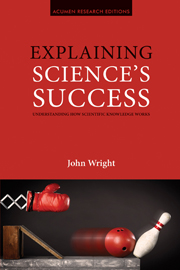Book contents
- Frontmatter
- Contents
- 1 Some surprising phenomena
- 2 Some unsatisfactory explanations of the phenomena
- 3 A defeasible a priori justification of induction
- 4 The independence of theory from data
- 5 Some more success-conducive properties of theories
- 6 Newton's laws of motion and law of gravitation
- 7 Special relativity
- 8 Mendelian genetics
- 9 Conclusion
- Notes
- Bibliography
- Index
4 - The independence of theory from data
- Frontmatter
- Contents
- 1 Some surprising phenomena
- 2 Some unsatisfactory explanations of the phenomena
- 3 A defeasible a priori justification of induction
- 4 The independence of theory from data
- 5 Some more success-conducive properties of theories
- 6 Newton's laws of motion and law of gravitation
- 7 Special relativity
- 8 Mendelian genetics
- 9 Conclusion
- Notes
- Bibliography
- Index
Summary
In the previous chapter it was argued that a theory arrived at by the straight rule from some body of data is more likely to lead to true predictions than other theories also compatible with the same data. This gives us a reason to prefer theories arrived at by the straight rule. But if we are confronted with any finite body of data, there will generally be a number of theories capable of being derived from those data by the straight rule.
Perhaps the most obvious way (to philosophers, at least) of generating indefinitely many generalizations from the same body of data using the straight rule is by using “grue/bleen” type predicates. The grue/bleen problem is discussed later in this chapter. But even without grue/bleen type predicates, it is still possible to use the straight rule to generate a number of different hypotheses from the same body of data. The history of science contains many such cases. For example, it may well have been the case that in the fifteenth century both the theory of Copernicus and a version of the Ptolemaic theory could both account for all the data that had been obtained up until that time. It would therefore have been possible to use the straight rule to make both of the following two inferences:
• Inference A: All available data conform to (a particular version of) the Ptolemaic theory; therefore all data (including data that will obtained in the future) conform to that theory.
• all data (including data that will be obtained in the future) conform to that theory.
- Type
- Chapter
- Information
- Explaining Science's SuccessUnderstanding How Scientific Knowledge Works, pp. 57 - 94Publisher: Acumen PublishingPrint publication year: 2012



